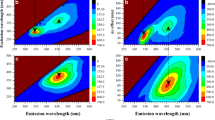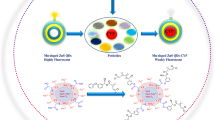Abstract
The purpose of this research is to develop a direct spectrometric approach to monitor soils and waters, at a lower cost than the widely used chromatographic techniques; a spectrometric approach that is effective, reliable, fast, easy to implement, and without any use of organic solvents whose utilization is subject to law limitation. It could be suitable at least as an alert method in case of massive contamination. Here, we present for the first time a catalog of excitation–emission and total synchronous fluorescence maps that may be considered as fingerprints of a series of homologated pesticides, in large use in Morocco, aiming at a direct detection of their remains in agricultural soils and neighboring waters. After a large survey among farmers, agricultural workers and product distributors in two important agricultural regions of Morocco (Doukkala-Abda and Sebou basin), 48 commercial pesticides, which are fluorescent, were chosen. A multi-component spectral database of these targeted commercial pesticides was elaborated. For each pesticide, dissolved in water at the lowest concentration giving a no-noise fluorescence spectrum, the total excitation-emission matrix (TEEM), the total synchronous fluorescence matrix (TSFM) in addition to synchronous fluorescence spectra (SFS) at those offsets giving the highest fluorescence intensity were recorded. To test this preliminary multi-component database, two real soil samples, collected at a wheat field and at a vine field in the region of Doukkala, were analyzed. Remains of the commercial Pirimor (Carbamate) and Atlantis (Sulfonylurea) were identified by comparison of the recorded TEEM, TSFM, and SFS to those of the preliminary catalog at one hand, and on the basis of the results of a field pre-survey. The developed approach seems satisfactory, and the fluorimetric fingerprint database is under extension to a higher number of fluorescent pesticides in common use among the Moroccan agricultural regions.







Similar content being viewed by others
References
Agence de Réglementation de la Lutte Antiparasitaire (2010) List of formulation products of ARLA http://publications.gc.ca/collections/collection_2010/arla-pmra/H114-22-2010-fra.pdf. Accessed 4 Jul 2014 (in French)
Andrade-Eiroa Á, Canle M, Cerdá V (2013) Environmental applications of excitation-emission spectrofluorimetry: an in-depth review I. Appl Spectrosc Rev 48:1–49
Barcelό D (1991) Occurrence, handling and chromatographic determination of pesticides in the aquatic environment. Analyst 116:681–689
Cachada A, Marques C, Pereira R, Gonçalves F, Duarte AC (2010) Development and application of an off-line SPE–LC–UV methodology for the determination of penoxsulam in aquatic systems adjacent to rice fields. Chromatographia 71:347–350
Cairns T, Sherma J (1992) Emerging strategies for pesticide analysis. CRC, Boca Raton
Carstea EM (2012) Fluorescence spectroscopy as a potential tool for in-situ monitoring of dissolved organic matter in surface water systems. In: Balkis N (Ed) Water Pollution, InTech, pp 47–68
Coble PG (1996) Characterisation of marine and terrestrial dissolved organic matter in seawater rising excitation-emission matrix spectroscopy. Mar Chem 51:325–346
Coble PG, Green SA, Blough NV, Gagosian RB (1990) Characterisation of dissolved organic matter in the Black Sea by fluorescence spectroscopy. Nature 348:432–435
Cornell University (2009) Pest management guidelines. CCE Cornell IPM guidelines http://ipmguidelines.org/home/content/book2/ch02/default.asp#%20Toc235336663. Accessed 4 Jul 2014
Deepa S, Mishra AK (2006) Synchronous fluorescence spectroscopy and its applications. ISRAPS Bulletin 18:4–8
Delaware Health and Social Services (2010) Organochlorine pesticides. Delaware. http://dhss.delaware.gov/dph/files/organochlorpestfaq.pdf. Accessed 4 Jul 2014
El Bakouri H (2006) Development of new techniques for the determination of pesticides and contribution to the reduction of their impact on water by the use of Natural Organic Substances (NOS). Dissertation, Université Abdelmalak Essaadi (in French)
El Khaddam S, Idrissi M, Achour S, Khadmaoui AE, Hadrya F, Soulaymani A, Soulaymani-Bencheikh R (2013) Acute pesticide poisoning in Tadla-Azilal region in Morocco: evolution and risk factors. International Journal of Innovation and Applied Studies (IJIAS) 3:552–559 (in French)
Gambacorta G, Faccia M, Lamacchia C, Di Luccia A, La Notte E (2005) Pesticide residues in tomato grown in open field. Food Control 16:629–632
Ghervase L, Ioja C, Carstea EM, Niculita L, Savastru D, Pavelescu G, Vanau G (2011) Evaluation of lentic ecosystems from Bucharest City. Int J Energy Environ 5:183–192
Glaser LC (1999) Organophosphorus and Carbamate Pesticides. In: Friend M and Franson JC (Eds) Field Manual of Wildlife Diseases, US Department of the Interior, US Geological Survey, pp 287–293
Guo W, Engelman BJ, Haywood TL, Blok NB, Beaudoin DS, Obare SO (2011) Dual fluorescence and electrochemical detection of the organophosphorus pesticides—ethion, malathion and fenthion. Talanta 87:276–283
Hudson N, Baker A, Reynolds D (2007) Fluorescence analysis of dissolved organic matter in natural, waste and polluted waters—a review. River Res Appl 23:631–649
John H, Worek F, Thiermann H (2008) LC-MS-based procedures for monitoring of toxic organophosphorus compounds and verification of pesticide and nerve agent poisoning. Anal Bioanal Chem 391:97–116
Kidd H, James DR (1991) The agrochemicals handbook, 3rd edn. Royal Society of Chemistry, Cambridge
Lartiges BS, Garrigues PP (1995) Degradation kinetics of organophosphorus and organonitrogen pesticides in different waters under various environmental conditions. Environ Sci Technol 29:1246–1254
Luciani X, Mounier S, Paraquetti HH, Redon R, Lucas Y, Bois A, Lacerda LD, Raynaud M, Ripert M (2008) Tracing of dissolved organic matter from the Sepetiba Bay (Brazil) by PARAFAC analysis of total luminescence matrices. Mar Environ Res 65:148–157
Luypaert J, Zhang MH, Massart DL (2003) Feasibility study for the use of near infrared spectroscopy in the qualitative and quantitative analysis of green tea, Camellia sinensis (L). Anal Chim Acta 478:303–312
Magdelaine C (2014) Pesticides or phytosanitary products. Notre-planete. http://www.notre-planete.info/ecologie/alimentation/pesticides.php. Accessed 3 Jul 2014 (in French)
Marco MP, Gee S, Hammock BD (1995) Immunochemical techniques for environmental analysis I. Immunosensors. TrAC Trends Anal Chem 14:341–350
Markechová D, Tomková M, Sádecká J (2013) Fluorescence excitation-emission matrix spectroscopy and parallel factor analysis in drinking water treatment: a review. Pol J Environ Stud 22:1289–1295
Maroc Press (2013) FAO warns against the dangers of pesticides. Infos afrikinfos. http://fr.afrikinfos.com/2013/08/05/la-fao-met-en-garde-contre-les-dangers-des-pesticides. Accessed 10 Jul 2014 (in French)
Mc Garvey BD (1993) High-performance liquid chromatographic methods for the determination of N-methylcarbamate pesticides in water, soil, plants and air. J Chromatogr 642:89–105
Namieśnik J, Jamrógiewicz Z (1998) Physico-chemical methods for environmental pollution control. WNT, Warszawa (in Polish)
Niemiec T, D’bski R, Kotarski J, Jackowska T, Jarosz A, Tomaszewski J, Weker H (2009) The statement of polish gynecologic society experts concerning drinking water consumption in women in reproductive age, pregnancy and breast feeding. Ginekol Pol 80:538–547 (in Polish)
Parlanti E, Wörz K, Geoffroy L, Lamotte M (2000) Dissolved organic matter fluorescence spectroscopy as a tool to estimate biological activity in a coastal zone submitted to anthropogenic inputs. Org Geochem 31:1765–1781
Patra D, Mishra AK (2002a) Recent developments in multi-component synchronous fluorescence scan analysis. TrAC Trends Anal Chem 21:787–798
Patra D, Mishra AK (2002b) Total synchronous fluorescence scan spectra of petroleum products. Anal Bioanal Chem 374:304–309
Peng Y, Li Y, Chen J (2012) Optical technologies for determination of pesticide residue. In: Theophile T (ed) Infrared Spectroscopy-Materials Science, Engineering and Technology, InTech, pp 453–466
Rubio L, Ortiz MC, Sarabia LA (2014) Identification and quantification of carbamate pesticides in dried lime tree flowers by means of excitation-emission molecular fluorescence and parallel factor analysis when quenching effect exists. Anal Chim Acta 820:9–22
Rubio S, Gomez-Hens A, Valcarcel M (1986) Analytical applications of synchronous fluorescence spectroscopy. Talanta 33:633–640
Sancho JV, Lopez FJ, Hernandez F, Hogendoorn EA, Van Zoonen P (1994) Rapid determination of glufosinate in environmental water samples using 9-fluorenylmethoxycarbonyl precolumn derivatization, large-volume injection and coupled-column liquid chromatography. J Chromatogr 678:59–67
Santos MJG, Ferreira MFL, Cachada A, Duarte AC, Sousa JP (2012) Pesticide application to agricultural fields: effects on the reproduction and avoidance behaviour of Folsomia candida and Eiseniaandrei. Ecotoxicology 21:2113–2122
Sherma J (1993) Pesticides. Anal Chem 65:40R–54R
Sherma J (1995) Pesticides. Anal Chem 67:1–20
Tankiewicz M, Fenik J, Biziuk M (2010) Determination of modern organophosphorus and organonitrogen pesticides in water samples. Trends Anal Chem 29:1050–1063
Tedetti M, Charrière B, Bricaud A, Para J, Raimbault P, Sempéré R (2010) Distribution of normalized water-leaving radiances at UV and visible wave bands in relation with chlorophyll a and colored detrital matter content in the Southeast Pacific. J Geophys Res 115:1–12
The National Pesticide Information Center (NPIC) (1998) Pyrethrins & pyrethroids. npic.orst http://npic.orst.edu/factsheets/pyrethrins.pdf. Accessed 4 Jul 2014
Vo-Dinh T (1978) Multicomponent analysis by synchronous luminescence spectrometry. Anal Chem 50:396–401
Wang HB, Zhang YJ, Xiao X, Yu SH, Liu WQ (2011) Application of excitation emission matrix fluorescence combined with second-order calibration algorithm for the determination of five polycyclic aromatic hydrocarbons simultaneously in drinking waters. Anal Methods 3:688–695
Willey JD, Atkinson LP (1982) Natural fluorescence as a tracer for distinguishing between piedmont and coastal plain river water in the near shore waters of Georgia and North Carolina. Estuar Coast Shelf Sci 14:49–59
Zhao H (2011) Analysis of organic matter and its properties in the natural environment with 3D fluorescence spectroscopy treated by PARAFAC. Dissertation, Université du Sud Toulon Var (in French)
Zhao W, Ge PY, Xu JJ, Chen HY (2009) Selective detection of hypertoxic organophosphates pesticides via PDMS composite based acetyl cholinesterase-inhibition biosensor. Environ Sci Technol 43:6724–6729
Zheng Z, Zhou Y, Li X, Liu S, Tang Z (2011) Highly-sensitive organophosphorous pesticide biosensors based on nanostructured films of acetyl cholinesterase and CdTe quantum dots. Biosens Bioelectron 26:3081–3085
Acknowledgments
Financial supports by the Moroccan “Centre National pour la Recherche Scientifique et Technique” (CNRST) in the framework of the research program “Developpement de la Recherche Sectorielle” project RS-12, and by the Portuguese “Foundation for Science and Technology” (FCT) in the framework of the bilateral cooperation CNRST (Morocco)/FCT (Portugal) Chimie/01-13/14 are gratefully acknowledged.
Author information
Authors and Affiliations
Corresponding author
Additional information
Responsible editor: Philippe Garrigues
Electronic supplementary material
Below is the link to the electronic supplementary material.
ESM 1
(PDF 4.78 mb)
Rights and permissions
About this article
Cite this article
Foudeil, S., Hassoun, H., Lamhasni, T. et al. Catalog of total excitation–emission and total synchronous fluorescence maps with synchronous fluorescence spectra of homologated fluorescent pesticides in large use in Morocco: development of a spectrometric low cost and direct analysis as an alert method in case of massive contamination of soils and waters by fluorescent pesticides. Environ Sci Pollut Res 22, 6766–6777 (2015). https://doi.org/10.1007/s11356-014-3807-6
Received:
Accepted:
Published:
Issue Date:
DOI: https://doi.org/10.1007/s11356-014-3807-6




